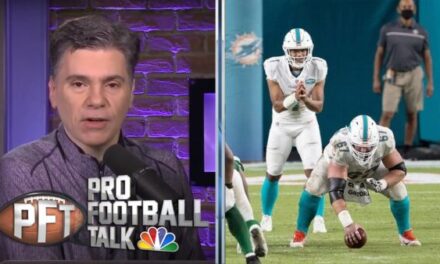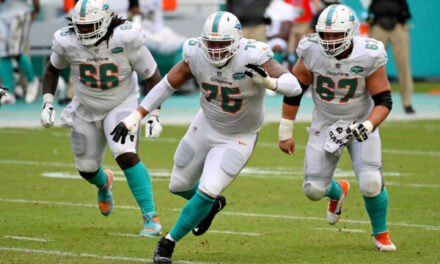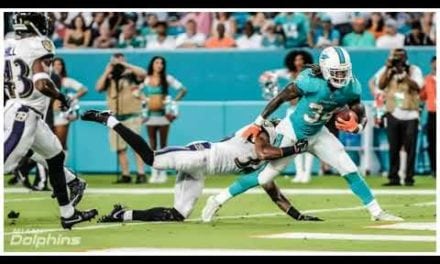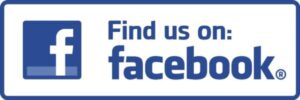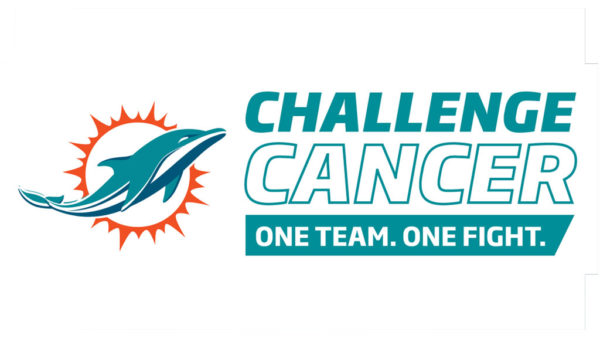
Unlike the previous week’s game against Washington, the Dolphins’ preseason finale vs. the Minnesota Vikings did have some calling it a potential Super Bowl preview.
In that day’s Miami Herald NFL preview special section, sports editor Edwin Pope predicted just that… the Vikings capturing the championship. Dolphins play-by-play announcer Rick Weaver opened the broadcast with, “These two teams could very well meet again in the Super Bowl.
After a turnover-filled first quarter, though, Weaver was singing a different tune, “The Alphonse and Gaston routine continues here in the first quarter.” BTW, that phrase means “a pair of persons (or teams in this case) treating each other with excessive deference, often to their detriment.” I figured since I wasn’t sure about it you might not be either.
Miami managed to emerge victorious 21-19 in what beat writer Bill Braucher called “a spectacular finish on a bizarre exhibition game.” Not exactly what Don Shula was aiming for in the final tune-up for the regular season. The way most teams approached their sixth(!) and final preseason game was as a dress rehearsal, playing their starters most, if not all, of the game.
Shula followed that plan in this game, playing Bob Griese all the way, and utilizing his three “starters” at running back to the exclusion of anyone else. The first-string defense played most of the game, too, with the exception of rookie Charlie Babb subbing at safety for the injured Jake Scott.
The Dolphins got their first look at Fran Tarkenton in a Minnesota uniform after being traded back to his original team by the New York Giants. He had led them to a 19-7 lead after three quarters. The Vikings had success moving the ball deep into Miami territory and needed to punt only once, but they had to mostly settle for short-field goals from veteran kicker Fred Cox.
The Dolphins began their comeback when Mercury Morris scored from eight yards out, helped by two devasting blocks from guard Larry Little. This cut the Minnesota lead to 19-14 with nine minutes remaining. The comeback appeared to be thwarted when Griese threw his third interception of the game with less than six minutes left. The Vikings took over at the Miami 27-yard line but generously fumbled the ball right back to the Dolphins three plays later. Bill Stanfill recovered at the 19 and gave the ball back to the offense with 3:32 left.
Griese shook off his interception problems and led Miami on a 10-play, 81-yard drive that took only two minutes and 40 seconds. Although Griese completed three passes, the biggest play came on one that fell to the ground. Minnesota defensive back Charlie West, thinking that Miami receiver Marlin Briscoe had beaten him, knocked him down. Or, as Rick Weaver said during the broadcast, “(West) really did a hatchet job on Marlin Briscoe. He knocked him almost up into the nickel seats.” That was just a phrase-tickets were less expensive back in the day, but not quite that cheap.
The Vikings’ penalty set Miami up at the 11-yard line with 1:14 left. On fourth-and-5 from the six-yard line, Mercury Morris scored once again on a sweep to put the Dolphins ahead for the first time in the game. Afterward, Griese said, “It was a nervy call…a gutsy call. I was just trying to call the play…the one they least would expect.” Yes, it was Griese’s call, as most quarterbacks called their own plays during that era. After two seasons playing for Shula, Griese had a good feel for how to use Miami’s devasting running game, now mixing more speed from Morris with the power of Csonka and the elusiveness of Kiick.
There was still enough time left for Tarkenton to move Minnesota into field goal range, but Cox missed the game-winning attempt from 44 yards out.
The Dolphins players and coaches were happy with the win, but it wasn’t pretty. Both teams had committed four turnovers, the kind of dress rehearsal that would close a show before it even debuted. Bill Braucher wrote, “it was also laden with more turnovers than a Pillsbury Bake-Off.” If you don’t know what that was, ask your mom.
Miami finished the preseason with a 3-3 record. There had been concern about the defense, which had given up nearly 20 points per game. To put that in perspective, Pittsburgh, Washington, and Green Bay had yielded barely more than 10 points per preseason contest.
It was now finally time to focus on games that would actually count. First, the roster for the opening game would have to be set. There was even more juggling and finagling with rosters during this era than there are today, with several different designations of players. I won’t dive into that minutiae-the numbers to know were the limits of 40 players (or employees as Braucher often called them) on the active roster and seven on the taxi squad (somewhat similar to today’s practice squad except that players in 1972 were locked into their current team).
The Dolphins selected 17 players in the 1972 draft, which lasted 17 rounds. Only three of them, defensive linemen Mike Kadish (1st round), linebacker Larry Ball (4th round), and safety Charlie Babb (5th round), made the team. Miami’s 3rd round pick, running back Gary Kosins, was waived. Shula had hoped to add him to the taxi squad, but he was claimed off waivers. Running back Ed Jenkins, an 11th-round choice was later named to the taxi squad. In 1971, only two rookies, defensive end Vern Den Herder and wide receiver Otto Stowe had made the opening day roster.
Don Shula had traded the 1972 second-round pick for Bob Matheson, and he had already traded the team’s 1973 first-round pick for Marlin Briscoe. While he was not quite at the level of Redskin coach George Allen’s “Over-the-Hill-Gang” desire to trade draft choices for veterans, Shula certainly did his share of that. Shula would not make a first-round selection until 1974, but it was hard to argue with the return the team received in first-round trades so far. In 1971, Miami traded with Cleveland to receive Hall of Fame receiver Paul Warfield, and in 1970 the return was Shula himself-commissioner Pete Rozelle assessed that penalty to the Dolphins for tampering while Shula was still employed by the Colts.
Ultimately, though, that trend, along with some misses on players they did draft, would come back and bite them in a few years. The Herald’s Edwin Pope had even expressed some concern after the Briscoe trade.
For now, however, it was full speed ahead into the 1972 season.
When Pope had made his selection of the Dolphins to repeat as AFC champions, he qualified it this way; “Fortune has kissed the Dolphins each of the last two seasons in this respect. They have had almost no long-term disabling injuries at critical positions. I believe the Dolphins will return to the Super Bowl if the injury charm lingers. But that’s an “if” as tall as Mt. Rainer.”
Another concern was Miami’s schedule, especially the first four games. Their 1971 schedule had been considered one of the weakest in the NFL but was expected to be tougher in 1972. The Dolphins would play three of those first four games on the road; at Kansas City, Minnesota, and New York against Joe Namath’s Jets. Braucher opined, “If they can survive a rough first month without getting discouraged, the road is downhill.”
Shula’s Dolphins had yet to win their opening game, losing in 1970 to the Boston Patriots 27-14 and stumbling to a 10-10 tie in Denver in 1971 while committing five turnovers. That was just another annoying trend that Shula was looking to turn around in 1972.
The excitement was building in Kansas City for the arrival of the Dolphins to open the regular season. The Chiefs and their fans were seeking some measure of revenge over the Christmas Day overtime playoff loss in the last game played in their old stadium and properly christening their brand new 78,000 seat showcase-Arrowhead Stadium.
Miami was expecting a challenge. Saturday, after the Dolphins arrived in Kansas City and had a brief workout at the new stadium, Shula said, “The important thing is that we’re aware of what’s in store for us.”
Coming Next Week: Part 8-Dolphins Set the Tone
With the temperature in new Arrowhead Stadium turned up to broil, the Dolphins carve up the Chiefs and set the tone for their historic season.

